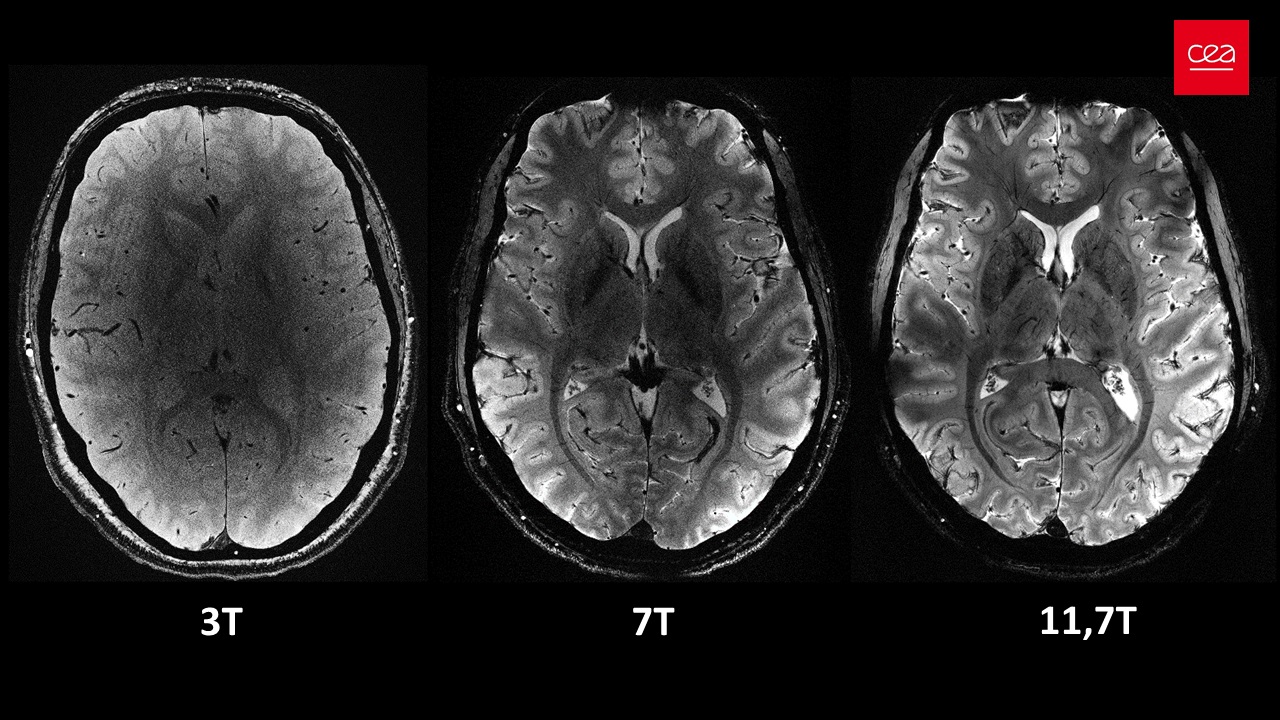Feast your eyes on this stunning picture from the world’s most powerful magnetic resonance imaging (MRI) machine. In just four minutes, this incredible piece of kit can acquire images at a resolution that would take hours for your average hospital scanner, giving scientists an unprecedented window into the human brain.
MRI scanners work by surrounding the body – or the bit of it you want to image – with a strong magnetic field. Most scanners used in medical setting can achieve a field strength of 1.5 or 3 teslas (T). The Iseult MRI machine responsible for these latest pics can get to 11.7T.
In practice, this means that this exceptional resolution can be achieved in a fraction of the time it would take for a 1.5 or 3T scanner.

You can clearly see the difference between the 3T scanner typical in hospitals, a 7T scanner that only some lucky researchers can get their hands on, and the new 11.7T scanner.
Image credit: CEA
If you’ve ever had an MRI, the first thing the technician probably told you was the importance of keeping completely still – this is because even the tiniest movement can create artifacts, blurring the images and ruining the view. The whole “keeping completely motionless in a loud coffin-like tube” thing would be much more comfortable if you only had to do it for a few minutes, rather than an hour or more.
But beyond just speed, the resolution offered by the Iseult MRI scanner can allow scientists to study healthy and diseased brains in living people to a very high level of detail.
In Alzheimer’s and Parkinson’s disease research, for instance, this could provide new information on the neurodegeneration that happens in different regions of the brain, and help improve diagnosis.
Using a field strength of this magnitude also allows the scanner to pick up certain chemical signals that can’t be detected with conventional scanners. One of these is lithium, a drug that’s sometimes used in the treatment of bipolar disorder. With this scanner, scientists will be able to see how the drug is distributed in the brain to better understand how it works.
“With the Iseult project, a whole new world is opening up before our eyes, and we are excited to explore it,” said project lead and Director of Research at the French Alternative Energies and Atomic Energy Commission (CEA), Nicolas Boulant, in a statement.
“Our goal is to investigate neurodegenerative diseases by 2026-2030, as well as other diseases that fall more under psychiatry, such as schizophrenia and bipolar disorders. Cognitive sciences will also be of key importance in our research!”

This level of detail could be useful in so many research applications.
Image credit: CEA
Development of this impressive machine has taken place over almost two decades, involving more than 200 people who have made the magnet, installed the equipment, developed the contrast agents that allow such clear images to be taken, and formulated new methods for getting the most out of such a powerful scanner.
The 132-ton machine is 5 meters (16.4 feet) in length and width, and contains 182 kilometers (113 miles) of superconducting wires. Liquid helium is used to cool the magnet right down to -271.35°C (-456.43°F).
“We are incredibly proud to see this end result of an almost 20-year-long R&D project,” said Anne-Isabelle Etienvre, Director of Fundamental Research at the CEA.
“Neuroscientists, physicists, mathematicians and physicians thus worked together to develop the tools and models that will help better understand how healthy and diseased brains work, expanding the horizons of explorations on the human brain.”
Source Link: The World’s Most Powerful MRI Machine Just Took Some Stunning Images